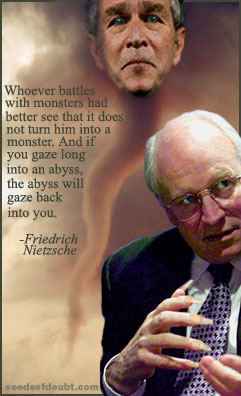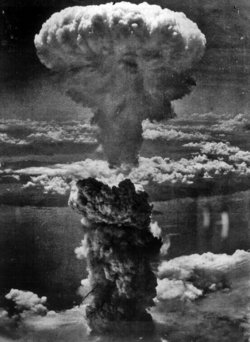| Published on Monday, February 13, 2006 by The Age / Australia |
| Brutal propaganda videos distributed by Iraqi insurgents underscore the growing challenge that confronts US and Iraqi security forces. |
| by Paul McGeough |
| The masked gunman cradles a sniper's rifle as he sits in the back of a car. Speaking to the camera, he taunts America's President with a chilling outline of his planned mission: "I'm going to give George Bush a small present. I have nine bullets — with each I'll shoot someone and, before your eyes, I'll give the present to Bush." Getting out of the car in a built-up area, he heads over rough ground to the corner of a building. The recording then cuts to a tightly spliced sequence of nine shootings, in which the targets appear to be members of the American or Iraqi security forces. It is pure and brutal propaganda. Some of the images are blurred and there is no proof that the man with the gun has even fired the shots. Each target seems to collapse as a single gunshot is heard, but there is no attempt to verify the gunman's claim that he has killed the victim. Nonetheless, this and three other video CDs gathered recently by The Age in Sunni communities near Baghdad are a graphic indication of how an emboldened insurgency is arming itself with high-tech propaganda as well as low-tech weaponry. Recorded at various times in the past two years, the footage suggests that the rebel fighters have a remarkable ease of movement in urban and rural Iraq; an ability to acquire the weapons and uniforms of the new Iraqi security forces; and they demonstrate their skill in crafting crude home-made missile launchers and improvised bombs for use in brazen daylight attacks on a range of military, political and economic targets. As the third anniversary of the March 20 invasion of Iraq looms, they underscore the daunting challenge that confronts American and Iraqi security forces. When told of the content of the videos, one of American's leading terror analysts, Bruce Hoffman of the Rand Corp, said they indicated that the insurgency was not just entrenched, but that it had become self-perpetuating. When The Age asked another high-profile US analyst, Anthony Cordesman of the Washington-based Centre for Strategic and International Studies, how the insurgency might be defeated, he replied: "It all depends on the political process. "There must be broad support from the Sunnis. But opinion polls show that more than 90 per cent of them think the elections were unfair and that the new government will be illegitimate." Despite the seeming order of elections in Iraq, it is the continuing failure of the political process that has created a power vacuum in which thousands of Americans and Iraqis have died, been wounded or captured in what has become a war of attrition with the insurgents. In the aftermath of the December 15 elections, it has taken two months for the victorious Shiite religious parties to agree on a candidate for the prime ministership and they have yet to negotiate the makeup of the next government. Officially, the cause of most of the 2260- plus American fatalities in Iraq is listed simply as "hostile fire". But there have been dozens of media reports of deaths and injuries by a single shot that go some way to confirming the sniper-inflicted US losses the insurgency attempts to glorify in its propaganda. However, official US acknowledgement of the insurgency snipers' competence is rare. Last year The Guardian quoted US troops at Camp Rustamiyah in Baghdad on their wariness of an elusive Iraqi sniper who they speculated might have killed a dozen of their colleagues. They claimed to have nicknamed him "Juba". In the previous year, US marines stationed in Fallujah marvelled to The New York Times at the prowess of what some believed was a single sniper who kept 150 Americans pinned down for the best part of a day. US aircraft dropped bombs and ground forces unleashed an estimated 30,000 rounds of automatic rifle fire before the sniper escaped — apparently on a bicycle, according to the Times. The insurgency has since produced news clips in which a series of sniper attacks — different from those on the videos seen by The Age — are attributed to Juba. They also released a video clip in which they say that an unseen marksman — only his hands and weapon are exposed to the camera — is Juba. Elsewhere, in internet chatrooms, there is a debate about whether he exists at all. But one of the more intriguing insights into the secretive world of the insurgency snipers was the capture by American forces of the sharp-shooter who took a shot at Stephen Tschiderer, a US Army medic, in Baghdad five months ago. Tschiderer was knocked off his feet by the force of the hit. But his body armour prevented any injury and he was able to help his mates give chase — and to treat wounds inflicted on his would-be killer as he was run to ground. A statement by the US Department of Defence on the discovery of the sniper's vehicle revealed incredible details of the Iraqi sniper and his accomplice's way of working: "The van was lined with diapers to muffle the sound (of shots). The vehicle contained a Russian sniper rifle, a 9-millimetre handgun, three hand grenades and a fourth grenade rigged to the fuel tank with a pin. "The soldiers also found a full bag of ammunition, as well as a video camera containing footage of (the attack on) Tschiderer. Two holes were cut in the back of the van — one for the camera and one for the weapon." The speech by the marksman in the video, is thought to be a new benchmark in an extensive, internet-driven propaganda campaign run by a range of insurgency groups. But stripped of crude enhancements and dubious editing techniques that are intended to make these film clips more appealing to impressionable young Muslim minds, they are a doorway into a violent world. They show rocket and mortar teams at work, often using crude launchers that appear to have been manufactured from lengths of water pipe and angle iron. Operating in broad daylight, the teams appear to launch missiles from busy, built-up areas — sometimes waiting for passers-by to remove themselves from the line of fire. Another remarkable sequence begins with an Iraqi take on what could be a group of labourers going to work anywhere in the world. Carrying tool boxes, they are seen climbing a ladder to the upper level of a two-storey building. The scene cuts to the men at work — drilling and hammering in a corner of a darkened room that gradually fills with light as they break open a narrow, horizontal slit high on a wall. They build a scaffold on which they erect what appears to be a home-made multiple rocket launcher, with the tube opening positioned against the slit they have cut in the wall. The scene cuts to the exterior of the building, showing the slit high on the wall that would hardly be noticed from outside until a series of missiles blast through it and towards an unseen target. The footage also shows rebel fighters attending classes in hand-to-hand combat and bomb-making. Hoffman says the insurgency film clips are spreading the jihadi propaganda at a quickening pace: "A depressing aspect of these videos is how they reveal the insurgency perfecting the low-risk means of war — it's unique stuff. Seeing them show people how to stage various attacks ratchets things to a new level. "The arms race we grew up with during the Cold War is unfolding at a different level and as quickly as the counter-insurgency catches up with it, the insurgency finds new ways. "That part of it is not new — it's how the IRA worked. But the ubiquity of loading a CD to instruct others shows how the information age of the 21st century cuts both ways — as an engine of enlightenment but also as the curriculum of warfare and terrorism. "It doesn't mean that the war is not winnable. But a new dimension is being set and the solution is not going to be quick and easy … historically it's taken a good decade to defeat most insurgencies. "These videos confirm that it's still early days in Iraq." Cordesman points to a dangerous double-up of circumstances in Iraq: "There already were a lot of weapons, ammunition and explosives in Iraq and you can't stop people improvising weapons — the Palestinians did it, the Afghans do it." Drawing out the theory of asymmetric war, in which varied technologies and tactics mean that the opposing armies bypass each other, he says: "The basic strategy of the insurgents is to avoid a direct fight … we don't train troops that way, but the insurgents must." Cordesman is the author of Iraq's Evolving Insurgency, an impressive etome that can be accessed on the CSIS website — www.csis.org — in which he constantly updates his analysis of the conflict in Iraq. He describes Iraq's massive stocks of arms and explosives as "a unique opportunity" for the insurgents, who have access to increasingly sophisticated trigger technology and the expertise to pack their improvised bomb with even greater firepower. Noting official Iraqi and US responses to fluctuations in data on the conflict, he observes dryly: "It's easy to claim a trend towards 'victory', but it's generally far more difficult to make them enduring or valid. Equally, it is easy to talk about 'tipping points' or 'turning points', but most such claims are wrong, over simplified and/or premature. "Real patterns take time to emerge and insurgencies are filled with cycles in which the patterns of a given day, week or month are reversed and later, reversed again." Copyright © 2006. The Age Company Ltd. |
Tuesday, February 14, 2006
Insurgents Resurgent
Subscribe to:
Post Comments (Atom)







No comments:
Post a Comment